Latin Name: Procyon lotor

Raccoons are warm-blooded animals found in areas with trees, including urban areas. These nocturnal animals are popular in temperate and tropical areas like Toronto, Central Florida, North Carolina, etc. They are small and adaptable and often feed on the carcass. Many of them feed on trees, but most of the successful ones live on the ground.
Although they can be mistaken for opossums and skunks, they are still easy to identify because of their distinguishing characteristics. They have a small sharp nose and small round ears. The most distinctive feature they have is their long, thick tail.
Raccoons are usually grey and black with a noticeable black “mask” over their eyes that help get the name “bandit.” They have four legs and a shape that looks stocky with a long and furry tail. They are mid-sized because they are about 2-3 feet in length and weigh about 23 pounds. However, they can be slim in warmer climates and weigh about 4 pounds but become rounder in cooler regions with up to 50% fat. Typically, their males are larger than the females. When you look at them closely, you will find a stripe running from their brow to their snout-like nose. They have mobile front legs with precise fingers-like paws that can even open-door handles. These skills help them hunt for food and help them survive in harsh conditions.
You can find raccoons in forest areas mostly or areas covered with trees generally. They like to make their home in hollow tree trunks, caves, and underground holes. During the day, they rest in trees and start their activities at night. They are excellent at climbing because they spend most of their time on trees. They are also good swimmers and do not have trouble hunting for food, even underwater. When they are in cold regions, they prefer to sleep during winter. Still, when they are in warmer climates, the sleep is only half-sleep because they go out once the weather is better.
They are popular in temperate and tropical areas between southern Canada and northern South America. They can also thrive in woodlands, urban, grasslands, and suburbs. All they need is an area that has enough water, trees, and large structures for protection.
They are primarily active at night than during the day as they spend most of their time resting in tree holes, dens, and secluded spots. When they are on transit, they can easily swim over streams and rivers and climb trees to get anywhere, searching for food. They use their legs to grab prey and tear them into bits. They are primarily omnivores and eat a variety of things for nutrition. Some of the things they eat are prey in ponds and streams, crabs, frogs, fish. They also gather nuts, worms, bugs, wild berries, and larvae. You will also find them feeding on wasps, crickets, and bugs.
They are can also be predatory, as sometimes they raid birds’ nests for their eggs and baby birds. They also eat small rodents and ravage through garbage cans for food. They can be problematic when they raid these areas because they cause damage.
Raccoons are as dangerous as the termites in your wood or the mosquitoes that are all about causing malaria. They are adaptive animals that can look harmless until they begin to cause severe damages. Some of the signs that show their infestation are:
Raccoons are a nuisance in the home. They can scratch, bite and carry several diseases to man. Some of the diseases they spread are in rabies virus and raccoon roundworm.
Raccoons display a significant degree of persistence and ingenuity that can be problematic, especially around humans. Some of the ways you can keep them away are:
If you suspect these pests are in or around your home, give us a call for a Free Home Inspection!
Loading…
